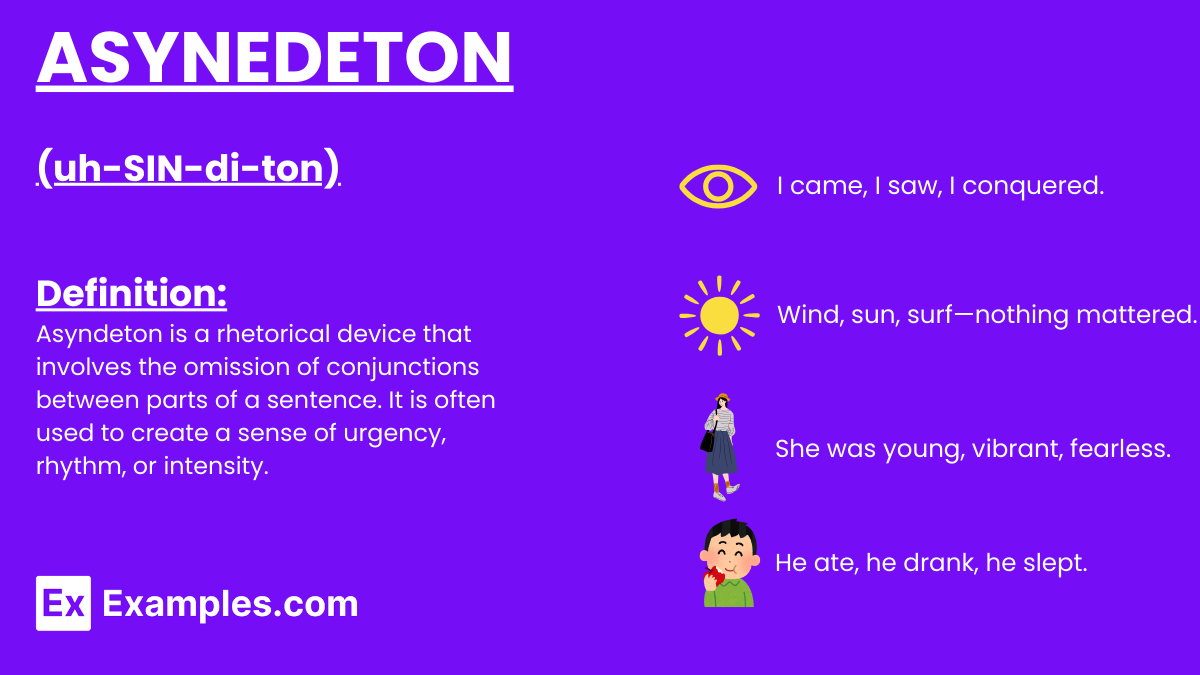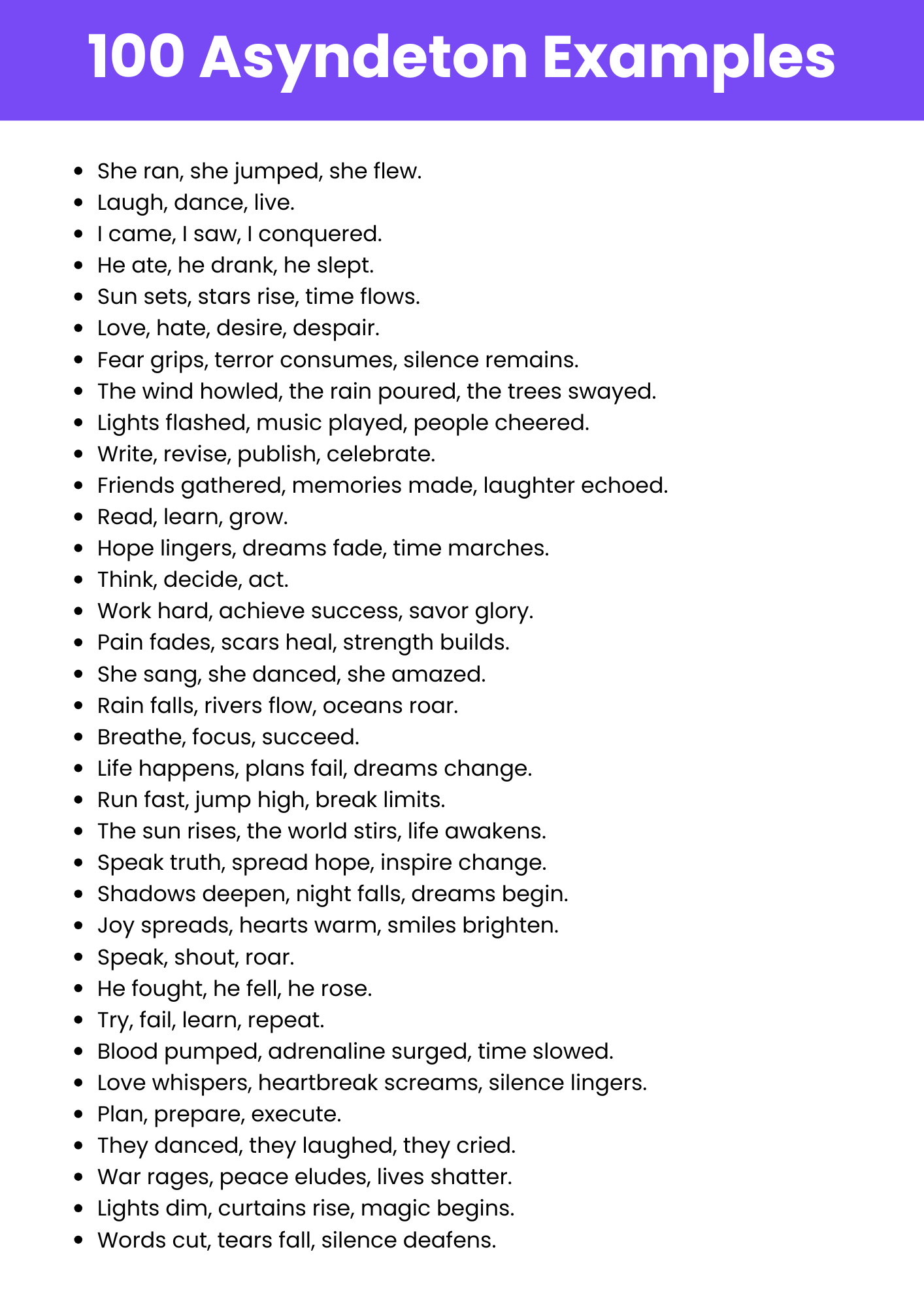Asyndeton
What is Asyndeton? – Definition
Asyndeton is a rhetorical device that involves the deliberate omission of conjunctions between a series of words, phrases, or clauses. This technique creates a concise and impactful statement, often speeding up the rhythm of the sentence and emphasizing the elements listed.

Generated Asyndeton Examples

Download Asyndeton Examples
Enhance your understanding with our comprehensive PDF guide.
Download PDFExamples of Asyndeton
- “I came, I saw, I conquered.” – Julius Caesar
- “He was brave, strong, resilient.” – Unknown
- “Life, liberty, happiness.” – Thomas Jefferson
- “Veni, vidi, vici.” – Julius Caesar
- “Eat, sleep, work.” – Common Saying
- “Friends, Romans, countrymen.” – William Shakespeare
- “Without pride and prejudice.” – Unknown
- “Stop, look, listen.” – Instructional Phrase
- “Ask not what your country can do for you.” – John F. Kennedy
- “We shall pay any price, bear any burden.” – Winston Churchill
- “Hear me, listen to me, understand me.” – Unknown
- “Rise, shine, conquer.” – Motivational Phrase
- “Learn, adapt, overcome.” – Inspirational Saying
- “See, believe, achieve.” – Success Mantra
- “Dream big, aim high.” – Motivational Phrase
Types of Asyndeton
Cumulative Asyndeton
This type involves adding multiple elements without conjunctions, building up to a climactic point or emphasizing the abundance of items.
- “He ran, jumped, climbed, laughed.” – Descriptive Action
- “Books, pens, notebooks, bags.” – School Supplies
- “Work, study, sleep, repeat.” – Daily Routine
- “Eat, drink, be merry.” – Encouragement to Enjoy
- “Laugh, dance, sing.” – Joyful Activities
Enumerative Asyndeton
This type lists multiple elements or ideas without using conjunctions, often to create a sense of urgency or to highlight the variety of items.
- “I bought apples, oranges, bananas.” – Shopping List
- “She sings, dances, acts.” – Talented Performer
- “Sunrise, sunset, moonrise.” – Daily Celestial Events
- “Fast cars, loud music, bright lights.” – Party Scene
- “Books, journals, magazines.” – Reading Materials
Dramatic Asyndeton
This type uses the omission of conjunctions to create a dramatic effect, often enhancing the emotional impact of a statement.
- “He is the king, he is the ruler.” – Assertive Declaration
- “Leave now, or never return.” – Ultimatum
- “Run, hide, survive.” – Urgent Commands
- “Fight, die, conquer.” – Battle Cry
- “Love, laugh, live.” – Inspirational Motto
How to Identify/Find Asyndeton?
To identify asyndeton, look for lists of words, phrases, or clauses where conjunctions like “and,” “or,” “but,” etc., are intentionally omitted. This omission often creates a fast-paced, dramatic, or impactful effect in the sentence.
- Identify sentences with multiple elements listed without the use of conjunctions.
- Look for a deliberate brevity or acceleration in the rhythm of the sentence.
- Notice if the omission adds emphasis or drama to the listed items.
- Analyze the context to understand why the conjunctions might have been omitted.
- Consider the overall impact on the sentence’s tone and pace.
How to Use Asyndeton?
Use asyndeton to create a sense of urgency, enhance the rhythm of your writing, or emphasize the importance of each element in a list. This technique can add drama, speed, and impact to your sentences, making them more memorable and engaging for the reader.
- List multiple items without using conjunctions to create a rapid, impactful effect.
- Use in speeches or persuasive writing to emphasize key points succinctly.
- Incorporate in descriptive passages to enhance the imagery and pace.
- Employ to highlight the importance of each element equally without one overshadowing the others.
- Ensure the omission serves a clear rhetorical or stylistic purpose in your writing.
Other Literary Devices
Asyndeton in Literature
Literary works often use asyndeton to create a sense of urgency, emphasize certain elements, or enhance the rhythm and flow of the narrative by omitting conjunctions in lists.
- “Veni, vidi, vici.” – Julius Caesar in *Julius Caesar* by William Shakespeare.
- “I came, I saw, I conquered.” – Julius Caesar in *The Dictator* by Larry Charles.
- “We shall pay any price, bear any burden.” – Winston Churchill in his speeches.
- “Fast cars, loud music, bright lights.” – Descriptive Scene in novels.
- “Laugh, dance, sing.” – Inspirational Quotes in literature.
Asyndeton Examples for Kids
Introduce children to asyndeton with simple and relatable examples that are easy to understand and remember.
- “Run, jump, play.” – Simple Instructions
- “Eat, sleep, repeat.” – Daily Routine
- “Laugh, sing, dance.” – Fun Activities
- “Read, write, draw.” – School Tasks
- “Jump, hop, skip.” – Playground Commands
Asyndeton Examples for Students
Enhance students’ understanding of asyndeton with examples that deepen their analytical skills and appreciation for rhetorical devices.
- “Government of the people, by the people, for the people.” – Abraham Lincoln
- “We shall fight on the beaches, we shall fight on the landing grounds.” – Winston Churchill
- “Buy land, they said; it will last forever.” – Unknown
- “He was smart, talented, hardworking.” – Descriptive Character
- “She was beautiful, kind, generous.” – Character Traits
Asyndeton Examples for Class 4
Age-appropriate and relatable examples of asyndeton for Class 4 students to grasp easily.
- “Eat, play, sleep.” – Daily Activities
- “Jump, run, slide.” – Playground Commands
- “Read, write, draw.” – School Tasks
- “Sing, dance, laugh.” – Fun Activities
- “Paint, color, create.” – Art Class Activities
Explore Other Literary Devices
Elevate Your AP English Preparation
Unlock your potential with our comprehensive AP English exam preparation tools designed to help you excel.
- Extensive Question Bank: Access 900+ exam-like questions for both AP English Language and Literature.
- Expertly Crafted: Questions mirror the structure and difficulty of actual AP exams, ensuring relevant practice.
- Detailed Explanations: Understand your mistakes with clear, concise breakdowns of correct and incorrect answers.
- Personalized Learning: Tailor your study sessions with topic-specific tests and adaptive learning tools.
- Comprehensive Coverage: Master all aspects of the AP English curriculum with extensive guides and resources.
Frequently Asked Questions
-
What is asyndeton in literature?
In literature, asyndeton is a rhetorical device where conjunctions are intentionally omitted between a series of words, phrases, or clauses. This technique creates a concise and impactful statement, often enhancing the rhythm and emphasis of the listed elements. -
How does asyndeton differ from polysyndeton?
While asyndeton involves the omission of conjunctions to create a rapid or impactful effect, polysyndeton is the use of multiple conjunctions in close succession. Asyndeton speeds up the rhythm, whereas polysyndeton slows it down and can add a sense of multiplicity or complexity. -
Can asyndeton be used in visual arts?
Yes, asyndeton can be applied in visual arts by arranging elements in a series without connectors, creating a streamlined and impactful composition. This can emphasize the relationship between elements and enhance the overall aesthetic. -
What is an example of asyndeton in movies?
An example of asyndeton in movies is the quote from *Julius Caesar*: “Veni, vidi, vici.” The omission of conjunctions between “came,” “saw,” and “conquered” creates a powerful and memorable statement. -
Why is asyndeton important in storytelling?
Asyndeton is important in storytelling because it enhances the pace and rhythm of the narrative, making descriptions more vivid and impactful. It can also emphasize the significance of each listed element, making the story more engaging and memorable for the reader. -
How can I effectively use asyndeton in my writing?
To effectively use asyndeton in your writing, identify lists of related elements where you want to create emphasis or a specific rhythm. Remove the conjunctions between these elements to streamline the sentence and enhance its impact. Ensure that the omission serves a clear purpose in conveying your message or theme.

